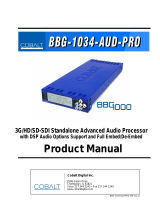
1 9902-UDX Functional Description
1-16 9902-UDX PRODUCT MANUAL 9902UDX-OM (V1.12)
Video Quality Events Detect Function
Option +QC provides a Video Quality Events user interface and an Event
Triggers
user interface for setting an area of concern across the program raster
which can be monitored for frozen or black video events. Threshold controls
allow setting the sensitivity of the function, while engage and disengage
threshold timing controls allow setting how fast the event detection engages
and releases when triggered. The
Event Triggers user interface allows
instructing the card as to the action to take upon an event (such as go to a
changed signal routing, activate a GPO, send an automated email, or go to a
user-defined preset).
Closed Captioning Events Detect Function
An Event Triggers user interface can detect Closed Caption Presence and
Closed Caption Absence events. The
Event Triggers user interface in turn
allows instructing the card as to the action to take upon an event (such as go to
a changed signal routing, activate a GPO, send an automated email, or go to a
user-defined preset).
Video Output Crosspoint
A four-output video matrix crosspoint allows independently applying the card
processed video output, reclocked input, or wings/key-fill previews to any of
the four card discrete coaxial outputs (
SDI OUT 1 thru SDI OUT 4). For an SD
output, a CVBS coaxial output is available as a processed video output.
An additional output (
RLY BYP B) provides a relay-protected output that
outputs a copy of
SDI OUT 1 crosspoint selection in normal operation. In
power loss failover
RLY BYP B passive outputs the signal connected to
SDI IN B.
Audio Processor Description
The audio processor operates as an internal audio router. This function
chooses from the following inputs:
• 16 channels of embedded audio from the SDI video input (default
1-to-1 routing to SDI output)
• Up to 16 channels (8 pairs) of discrete AES input
1
• Up to 4 channels of balanced analog audio input
(See Figure 1-6.) The audio processing subsection is built around a card
internal 16-channel audio bus. This 16-channel bus receives inputs from an
input routing crosspoint that routes de-embedded, and discrete AES and
analog audio inputs, over the 16-channel card bus. Correspondingly, at the
output end of the 16-channel bus is an output routing crosspoint that in turn
distributes the 16-channel bus signals to embedded, and discrete AES and
analog audio outputs.
1. Discrete audio I/O channel count is dependent on rear I/O module used. Not all rear I/O modules
may support maximum number of available discrete channels.






















